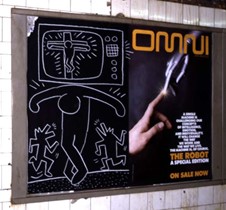Film and Television were the most popular artforms of the 20th century in America. Their cultural influence was felt across spheres as diverse as politics, fashion, design and publishing. Notwithstanding the wealth of academic discourse on the cultural, industrial and social history of the moving image in relation to these and other fields there still remains much work to be done on how American artists figured film and television as both distinct subjects and tools for the creation of artworks. This lecture series will present a varied roster of talks that will examine the moving image as both subject and practice in American art. We will explore a diversity of periods, artists and approaches to both film and television, observing the Art History of the moving image from an interdisciplinary perspective.
Session 3: Tom Day, ‘False Advertising: The Reception of Television and the Creation of Art in the East Village’
Much of the East Village art scene in Downtown Manhattan from the late 1970s onwards dealt with the aesthetic and cultural inheritance of television as mass media form. In several striking ways the screenings, art and video works organised and made by members of the clique which amassed around Club 57 (a seminal multidisciplinary arts, music and performance space open on St. Mark’s Place in the East Village from 1978-1983) concerned themselves with television as a dominant media form and with the legacy of underground cinema culture of the 1960s.
In this lecture I explore the construction of a queer community whose relationship to television promoted both nostalgic and camp reassessments of mainstream TV and the creation of works of art, performance and video that took an ambivalent perspective on such TV shows and advertisements. Through an accounting of screenings at the club that distinctly echoed similar modes of reception in the New York cinema underground of the 1960s, and an analysis of a number of artworks by club habitués and participants, including Keith Haring, Kenny Scharf, Ann Magnuson and Tom Rubnitz, I take seriously the claim of curator Marc H. Miller that ‘Club 57 heralded the arrival of the TV generation into the art world’.
Tom Day is a Terra Foundation Postdoctoral Fellow at The Courtauld’s Centre for American Art where he is working on a co-edited collection of essays entitled Pop Cinema (under consideration with Edinburgh University Press) examining the relationship between Pop art and experimental forms of cinema and television. He was previously a Postdoctoral Fellow at the Paul Mellon Centre for Studies in British Art/Yale Center for British Art where he completed a research project on the relationship between television and sculpture: ‘Making it Function Differently: TV Sculpture’. He is also currently completing a monograph, 100 Film and TV Artworks, for Bloomsbury Academic/British Film Institute and from October 2021 will be offering a special option MA at The Courtauld: ‘“Drop Dead” New York: Art, Film and Activism Downtown, 1971-1992’.


Support us
The Courtauld is an international community of influential art enthusiasts, thought leaders and change makers. Your support will help shape the future of art history. If you can, please make a donation or join the art movement and become a Friend today.